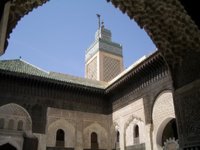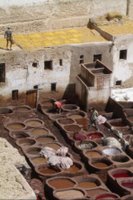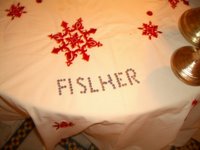
In the ongoing Adventures in Morocco series, I shall now discuss Fes. Known to some as Fez. Not too long ago, although it seems like ages, we spent four days in Fes, wandering the medieval streets and generally feeling somewhat alien. Some thoughts on the experience:
Orientation. There are essentially three sections to Fes. The oldest part of town is the medina, known as Fes el Bali and also with a section known as Fes el Andalous. Next oldest is Fes el Djedid, located southwest of Fes el Bali. Then, there's the Ville Nouvelle, the newest part of town, built by the French. For our purposes, Fes el Bali is the focus. We made brief forays into the other parts of town, but found Fes el Djedid underwhelming and a new city is a new city.
 Where to stay. It used to be that, back in the day (like when my parents were there circa 1971), westerners could only stay in the new city. Not so anymore. The trend of converting private riad homes into small hotels has definitely hit Fes, and I would recommend taking advantage. We stayed at Riad Louna, and I would highly recommend it. Affordable and lovely, with a cool courtyard for daytime siestas and a breezy rooftop for evenings. It's just a bit inside the medina from Bab Boujeloud (one of the old gates to Fes el Bali), so it is easy to access by taxi when you arrive, but you're also right near the medina.
Where to stay. It used to be that, back in the day (like when my parents were there circa 1971), westerners could only stay in the new city. Not so anymore. The trend of converting private riad homes into small hotels has definitely hit Fes, and I would recommend taking advantage. We stayed at Riad Louna, and I would highly recommend it. Affordable and lovely, with a cool courtyard for daytime siestas and a breezy rooftop for evenings. It's just a bit inside the medina from Bab Boujeloud (one of the old gates to Fes el Bali), so it is easy to access by taxi when you arrive, but you're also right near the medina.The big, fancy hotel in town is the Palais Jamai. All the books say it's swank, but it definitely has that big colonial hotel feel (it is a Sofitel, after all) and it's perched on the very edge of the medina, so I would only recommend it if you're not looking for any authenticity. If you're looking to splurge, riad style, La Maison Bleue and its sister property, Riad Maison Bleue, is the swankiest option. We had dinner there, discussed below, but I can't say it is fantastic enough to justify the proportional price increase. To give a sense, Riad Louna: $85/night, Maison Bleue: $200/night.
What to do. Fes is definitely a walking-and-looking type destination. The obvious place to engage in such activity is Fes-el-Bali. Given our brief tastes of Fes-el-Djedid (the newer quarter) and Fes Nouvelle (the even newer quarter), I'd stick with the medina. There are not so many big sights, as the major monuments are religious ones and non-muslims may not visit mosques in Morocco. So, sightseeing involves much observation of street life, some peeking behind doors, some shopping, and some sitting and sipping tea. Now, all the books say you need a guide for the medinas in Morocco. This is true and not true. The reality is that wandering by yourself and going with a guide are two different experiences. I would recommend both. To illustrate:
Day Without Guide. Our first day we decided we would tackle the medina by ourselves, with the trusty Rough Guide in hand. We accomplished this fairly well. We set out from the Riad Louna and headed towards the major landmark, the Kairaouine Mosque. This is fairly easily accomplished as Rue Talaa is pretty much a straight shot. Along the way, we
 admired the Bou Inania Medersa and generally observed the bustling alleys. We then took a little detour through Place Seffarine and eventually gave in to a fellow offering to take us to see the tanneries. So we climbed our way up to one of the shops with views over the tanneries, took some photos, declined to purchase leather goods, and made our way back down.
admired the Bou Inania Medersa and generally observed the bustling alleys. We then took a little detour through Place Seffarine and eventually gave in to a fellow offering to take us to see the tanneries. So we climbed our way up to one of the shops with views over the tanneries, took some photos, declined to purchase leather goods, and made our way back down. Then we did some aimless (not quite lost) wanderings for a few hours and snaked our way through the souks (collections of alleys selling or making certain kinds of goods: Dyers' Souk, Brass Souk, Leather Souk, etc.) and finally made our way back to the riad. Now, all of this was quite doable and Fes el Bali is contained by city walls, so you can only get so lost. There are these tourist maps and marked "routes" through Fes el Bali, but so far as we could tell they were utterly useless. I'd go with the internal compass.
Day With Guide. The next day we got a guide (We did this by asking at the riad, which I'd recommend as that way you get someone licensed by the tourist authority. That doesn't mean you aren't still going to get taken to carpet shops, but at least you've got a set price and someone to complain to). Our man Mustaffa, after being told that we'd hit some key sights the day before, suggested we taxi our way to the Andalusian Quarter and then make our way back through the medina, east to west. So off we went.
The Andalusian Quarter (Fes el Andalous) was a treat, as it was a bit off the tourist trail and had a real whiff of authenticity to it. We walked from Bab Ftouh (Bab = gate in the city walls) through some market streets to the Medersa Es Sahrij.
 Medersas are buildings that house koranic students who come to study at the local mosques. Fes's traditional role is as a center of islamic study, so the place is crawling with medersas, and these places are still used. In contrast to the Medersa Bou Inania, from the day before, which was all cleaned up for visitors, the Es Sahrij was in scenic disrepair and still had students living there. You could peek through the windows at the little cell-like rooms where the students lived (apparently most of them are from West Africa), and they were outfitted with the traditional accoutrement, like posters of favorite soccer players. The traditional layout is student rooms surrounding a central courtyard with a pool and fountain, and a prayer room at the one end of the first floor. Makes for nice pictures of reflections of tilework in the pool.
Medersas are buildings that house koranic students who come to study at the local mosques. Fes's traditional role is as a center of islamic study, so the place is crawling with medersas, and these places are still used. In contrast to the Medersa Bou Inania, from the day before, which was all cleaned up for visitors, the Es Sahrij was in scenic disrepair and still had students living there. You could peek through the windows at the little cell-like rooms where the students lived (apparently most of them are from West Africa), and they were outfitted with the traditional accoutrement, like posters of favorite soccer players. The traditional layout is student rooms surrounding a central courtyard with a pool and fountain, and a prayer room at the one end of the first floor. Makes for nice pictures of reflections of tilework in the pool.From there we made our way through the quarter, did a fly-by of the Andalusian Mosque (really not so interesting when all you can do is look at the front gate), crossed the river and headed into Fes el Bali. At this point we entered into what is the eternal struggle of the traveller in Morocco: the shops. Now, pretty much any guide is going to suggest going to some shops to you. Maybe a carpet shop, maybe an antiques shop, maybe a spice shop, but definitely some kind of shop. Some people are very put off by this as they feel they are getting ripped off. Some people are very uncomfortable as they feel they have to buy something in each shop.
 My approach is that, in many instances, these shops are part of the tourist experience - you see a slice of life, you get a chance to talk to people, and maybe you find something cool to buy. I figure, go in a few shops, have a chat with the storekeeper, look around and if you don't like anything, leave. If you do see something you like, then all the better. Another upside is they give you lots of mint tea while you're shopping, which is always nice.
My approach is that, in many instances, these shops are part of the tourist experience - you see a slice of life, you get a chance to talk to people, and maybe you find something cool to buy. I figure, go in a few shops, have a chat with the storekeeper, look around and if you don't like anything, leave. If you do see something you like, then all the better. Another upside is they give you lots of mint tea while you're shopping, which is always nice.In addition to a carpet shop in an old palace with a really cool roof overlooking the city, we checked out a spice shop with the requisite Bill Clinton photos on the wall, and an antiques shop with gorgeous doors and window frames from old palaces, if you need such a thing for your home.
 Mustaffa mixed up the shops with trips behind doors that I never would have opened on my own, where we saw squatters living in old palaces and fondouks (former hotels for caravans of traders) now serving as small factories for artisans, and different kinds of local people coming and going. As Mustaffa explained it, each little area of the medina needs three things: a baker, a mosque, and a hammam (communal bathhouse). The theory seemed to hold true, although I think I'd add mules to the list.
Mustaffa mixed up the shops with trips behind doors that I never would have opened on my own, where we saw squatters living in old palaces and fondouks (former hotels for caravans of traders) now serving as small factories for artisans, and different kinds of local people coming and going. As Mustaffa explained it, each little area of the medina needs three things: a baker, a mosque, and a hammam (communal bathhouse). The theory seemed to hold true, although I think I'd add mules to the list.Other random adventures. A few other tidbits from our handful of days in Fes.
Skip the Boujeloud Gardens. They're seriously tragic, and light on garden. Although at dusk, there was definite people watching to be done (and I was eternally amused by the new Christina Aguilera song blasting from someone's radio).
Street food. It may or may not have made me violently ill for several days, but there's some decent street food to be had. We had tasty kefta sandwiches (sort of spicy meatballs in pita) and the peelable fruit looked pretty decent.
"Palace" dinner. This is one of the junkets in Morocco: a dinner in a fancy riad or
 palace hotel, complete with multi course meal, low tables with cushions, and entertainment. We went to Maison Bleue, noted above. So the place is nice, it's a lovely tiled Moroccan riad. The service is attentive. The atmosphere would have been romantic (pillows, candles) if there wasn't a group of three middle-aged American couples at the next table. The food was good, but good Moroccan food is just okay. So there it is. The most entertaining part: how they (mis)spelled your name on your table.
palace hotel, complete with multi course meal, low tables with cushions, and entertainment. We went to Maison Bleue, noted above. So the place is nice, it's a lovely tiled Moroccan riad. The service is attentive. The atmosphere would have been romantic (pillows, candles) if there wasn't a group of three middle-aged American couples at the next table. The food was good, but good Moroccan food is just okay. So there it is. The most entertaining part: how they (mis)spelled your name on your table. Money. The ATM situation in Fes el Bali is extremely limited and all but one (which wasn't working when we were there) are closed on the weekends. So definitely stock up on cash near the train station in the new city or on weekdays. Most places are cash only, including riads, so it's pretty vital.
Pictures. Because many of the streets are covered alleys, taking pictures can be a challenge. Definitely bring a decent camera so you can adjust for the fluctuating light. My souk pictures didn't come out so well, but I think with some more premeditation, there are some pretty great shots to be had.
1 comment:
Brilliant summary - Jon and I will definitely use these posts when we're in Morocco in January. I can't believe the ATMs are closed on weekends. How do you close an ATM, exactly?
Post a Comment